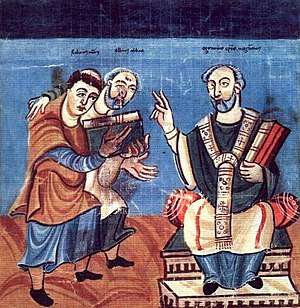782
Year 782 (DCCLXXXII) was a common year starting on Tuesday (link will display the full calendar) of the Julian calendar. The denomination 782 for this year has been used since the early medieval period, when the Anno Domini calendar era became the prevalent method in Europe for naming years.
| Millennium: | 1st millennium |
|---|---|
| Centuries: | |
| Decades: | |
| Years: |
|
| 782 by topic |
|---|
| Leaders |
| Categories |
|
| Gregorian calendar | 782 DCCLXXXII |
| Ab urbe condita | 1535 |
| Armenian calendar | 231 ԹՎ ՄԼԱ |
| Assyrian calendar | 5532 |
| Balinese saka calendar | 703–704 |
| Bengali calendar | 189 |
| Berber calendar | 1732 |
| Buddhist calendar | 1326 |
| Burmese calendar | 144 |
| Byzantine calendar | 6290–6291 |
| Chinese calendar | 辛酉年 (Metal Rooster) 3478 or 3418 — to — 壬戌年 (Water Dog) 3479 or 3419 |
| Coptic calendar | 498–499 |
| Discordian calendar | 1948 |
| Ethiopian calendar | 774–775 |
| Hebrew calendar | 4542–4543 |
| Hindu calendars | |
| - Vikram Samvat | 838–839 |
| - Shaka Samvat | 703–704 |
| - Kali Yuga | 3882–3883 |
| Holocene calendar | 10782 |
| Iranian calendar | 160–161 |
| Islamic calendar | 165–166 |
| Japanese calendar | Ten'ō 2 / Enryaku 1 (延暦元年) |
| Javanese calendar | 677–678 |
| Julian calendar | 782 DCCLXXXII |
| Korean calendar | 3115 |
| Minguo calendar | 1130 before ROC 民前1130年 |
| Nanakshahi calendar | −686 |
| Seleucid era | 1093/1094 AG |
| Thai solar calendar | 1324–1325 |
| Tibetan calendar | 阴金鸡年 (female Iron-Rooster) 908 or 527 or −245 — to — 阳水狗年 (male Water-Dog) 909 or 528 or −244 |

Events
By place
Byzantine Empire
- Arab–Byzantine War: Arab forces (95,000 men) under Harun al-Rashid, son of the Abbasid caliph Al-Mahdi, cross the Taurus Mountains and capture the Byzantine border fortress of Magida. Harun leaves his lieutenant Al-Rabi' ibn Yunus to besiege the city of Nakoleia (Phrygia), while another force (30,000 men), probably under Yahya ibn Khalid, is sent to raid the western coastlands of Asia Minor. Harun himself, with the main army, advances to the Opsician Theme.
- Summer – Harun al-Rashid reaches as far as Chrysopolis, across the Bosporus Straits from the Byzantine capital, Constantinople. After the defection of the Armenian general Tatzates, Empress Irene accepts a three-year truce, including the annual payment of a tribute of 70,000 or 90,000 gold dinars, and the handing over of 10,000 silk garments. Harun releases all his captives (5,600 men), including chief minister Staurakios and other hostages.[1][2]
- Emperor Constantine VI is betrothed to the 6-year-old Rotrude, daughter of Charlemagne; Irene sends a scholar monk called Elisaeus to educate her in Greek language and manners.[3]
Europe
- Summer – Saxon Wars: King Charlemagne sends a punitive expedition (an elite force of Eastern Frankish troops) under the command of Adalgis the Chamberlain, Gallo, and Worad, supported by Saxon forces, to deal with the Saxons and Sorb raiders in Thuringia.[4]
- Battle of Süntel: The Franks under Charlemagne are defeated by Saxon rebels, led by Widukind. He succeeds in wiping out more than half of the occupying Frankish forces and again raises the banner of revolt.
- Autumn – Charlemagne returns from his campaign in Italy, and musters a Frankish army of available troops in Bavaria. He then marches to Saxony, probably to Eresburg. Charlemagne marches north, down the Weser to the Aller River, making camp near Verden.[5]
- Massacre of Verden: Charlemagne executes 4,500 rebel Saxons at Verden for practicing paganism. He issues the Capitulatio de partibus Saxoniae and imposes Christianity on the Saxons, making Saxony a Frankish province.
- Charlemagne summons Alcuin, Anglo-Saxon missionary, to Aachen, and appoints him as chief adviser on religious and educational matters. He becomes the leading scholar and teacher at the Carolingian court.
By topic
Religion
- Nanchan Temple on Wutaishan, Shanxi, is built during the Tang Dynasty (China).
Births
- Tachibana no Hayanari, Japanese calligrapher (d. 844)
Deaths
- January 11 – Kōnin, emperor of Japan (b. 709)
- September 28 – Leoba, Anglo-Saxon nun
- Conall mac Fidhghal, king of Uí Maine (Ireland)
- Thierry IV, Frankish nobleman (approximate date)
gollark: They're small primes.
gollark: I just twiddled with the settings to make it easier if a valid hedgehog is supplied.
gollark: No, you could uninstall it before.
gollark: Haskell.
gollark: This is the internet. Is that right?
References
- Garland 1999, pp. 76–77.
- Treadgold 1997, p. 418.
- Runciman, Steven. "The Empress Irene the Athenian." Medieval Woman. Ed. Derek Baker. Oxford: Ecclesiastical History Society, 1978.
- David Nicolle (2014). The Conquest of Saxony AD 782–785, p. 51. ISBN 978-1-78200-825-5.
- David Nicolle (2014). The Conquest of Saxony AD 782–785, p. 65. ISBN 978-1-78200-825-5.
This article is issued from Wikipedia. The text is licensed under Creative Commons - Attribution - Sharealike. Additional terms may apply for the media files.